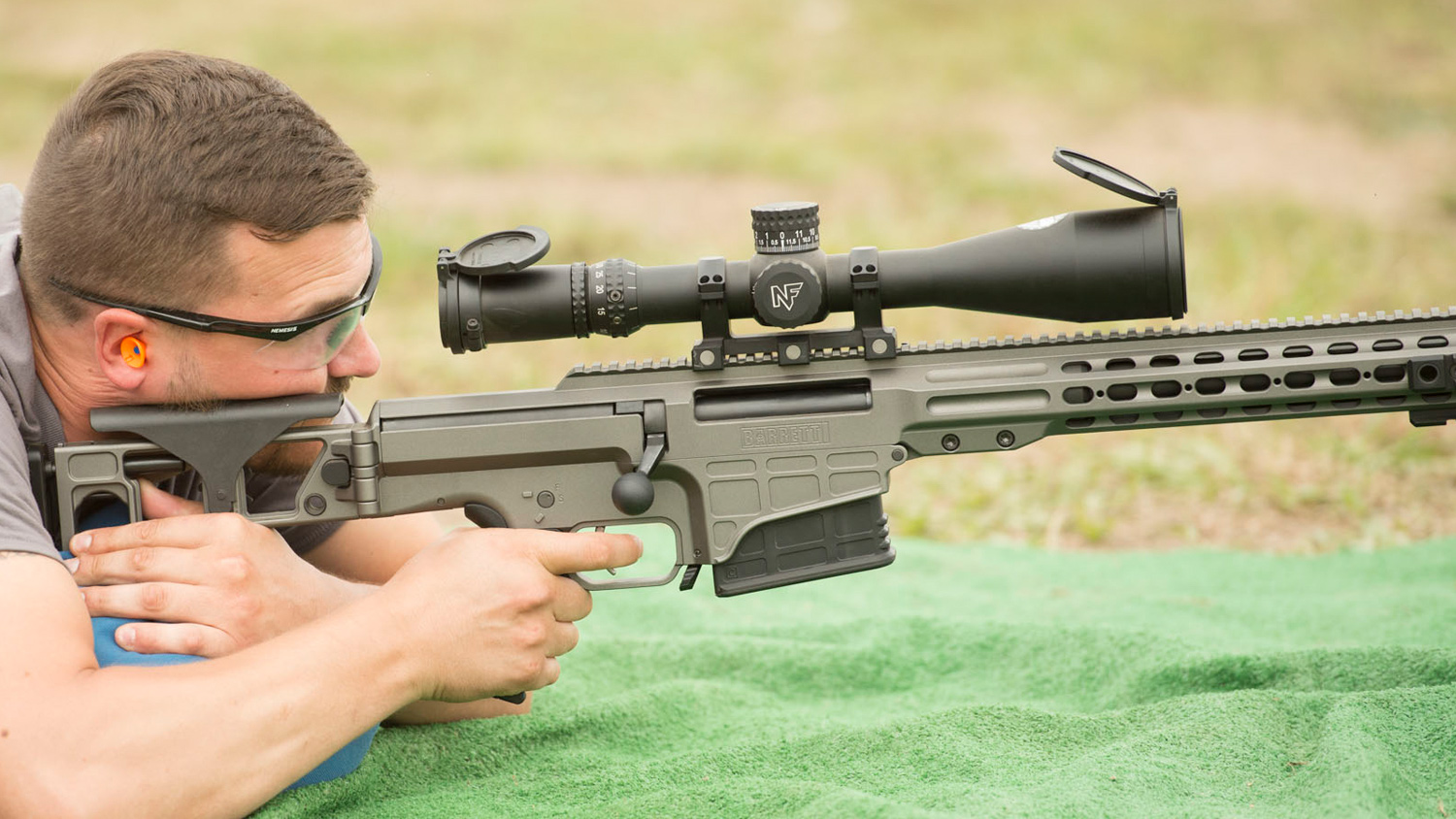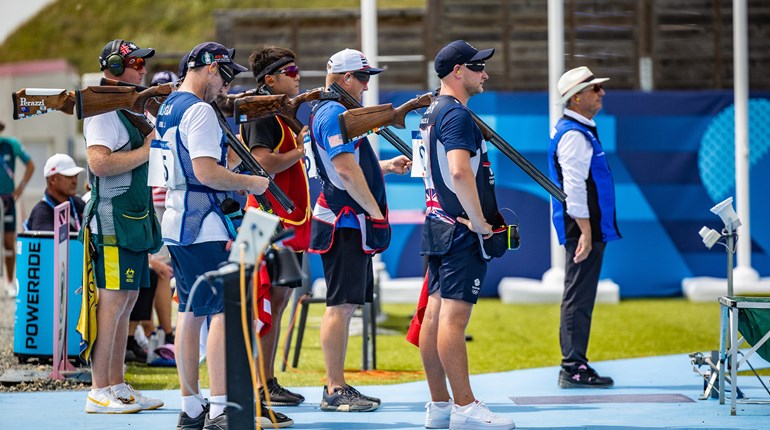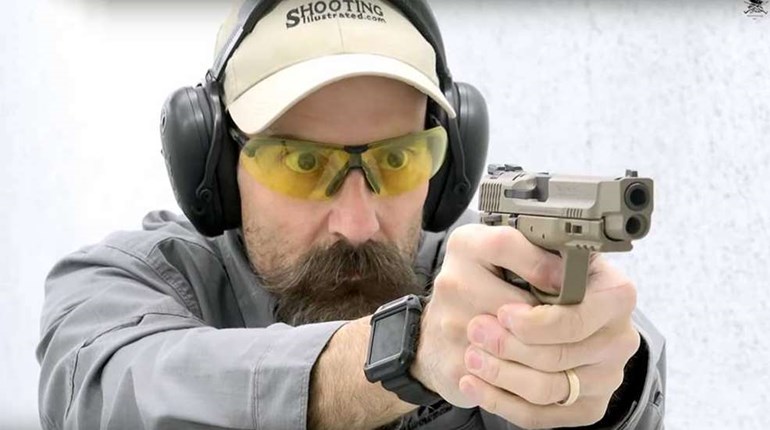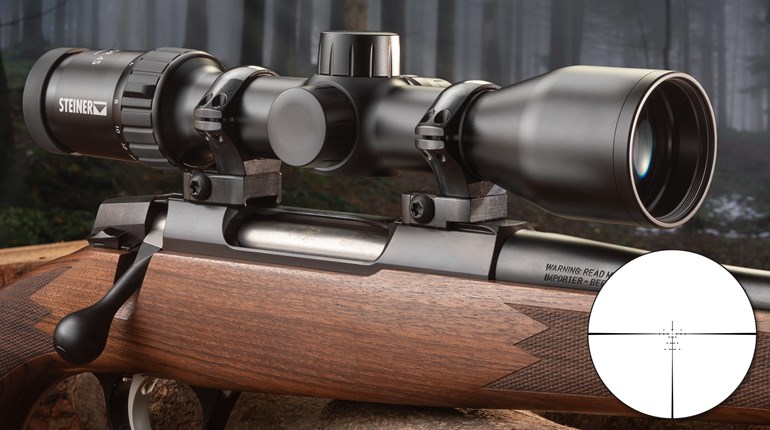
Its sweltering rhythm routinely produces the kind of hypnotic trance capable of confusing even veteran outdoorsmen. In the Southwest’s vast Sonora Desert, where I grew up, Gila monsters, Mohave rattlers, monolithic saguaros and the mirage that made them all dance were routine.
I’m not talking about those infamous curvaceous visits in the setting afternoon sun. Mirage is much more than myth. Its little white lie proved deadly to hundreds of pioneers as they steered West, toward a shimmering promise of water on a horizon they could never reach.
Long-distance shooters, on a regular basis, are also faced with mirage. And whether they resign themselves to simply cursing its perpetual motion, or decide to wrestle with the basic understanding necessary to interpret its fluid subtleties, can make all the difference between a shot landing squarely in the X-ring or being victimized by an undetected downrange breeze.

Light Fare
What we see around us is actually the result of light’s reflection off the object, capture of that reflection by the human eye, and ultimately, interpretation by the brain. A practical illustration of this principle is seen in a nighttime driver’s ability to see a highly reflective stop sign at a considerable distance in their headlights, while much closer—and less reflective—trees, pedestrians or deer can seem virtually invisible.
It’s also seen in the way a flashlight’s beam seems to thin and fade away into the night. Despite the fact that it is still transmitting light, unless it strikes a surface capable of reflecting the light back to your eyes, our brain interprets it as simply vanishing.
Light waves, including reflected light, travel in a straight line in a vacuum, or through any medium of uniform density and composition. This grossly oversimplified explanation is what allows you to accurately aim your firearm at the bullseye.
But when light is transmitted through materials of differing densities or multiple materials, it can bend, or refract. Drop a pencil into a clear glass of water, and it appears broken or disjointed where the air and water meet—where the light is being transmitted through two different density materials. Although you may have never realized it, this “mirage” is the result of light being refracted (bent) as it leaves the water and enters the surrounding air. The dry end’s image remains “true” because its reflected light passes through only one medium—air—on its way to your eye.

Mind Games
That imaginary pool of water you often see on a highway’s horizon on hot days is also mirage. Much like the illusion that the submerged end of the pencil has bent, light’s refraction is at the heart of this distant oceanic promise.
Here’s how temperature creates that distant and shimmering pool. When a relatively dark highway’s asphalt soaks up the sun’s warmth, air directly overhead is heated faster than elsewhere along the horizon. Because the heated air’s density is slightly different than that of the surrounding colder air, the exact conditions that create the disjointed-looking pencil are duplicated in the sky—or more accurately, just above the asphalt. When a viewer looks at the refraction at the proper angle, an image of the sky is reflected, and that ghostly “sea” suddenly appears. This also explains why mirage is most often seen from near the ground, and totally absent from higher points of view.
It’s not a watering hole shooters are interested in though—not during the heat of competition anyway. Veteran long range competitors are looking for warm air rising from the ground as it is being replaced with colder air—an exchange rendered visible by virtue of that same mirage-inducing refraction.
Typically, the ability to detect mirage is maximized on warm, sunny and sultry days. Expect mirage to be most pronounced in mid-morning or early afternoon, although it ignores these rules with regularity. It is best viewed against a dark, preferably black, background, exactly why those infamous ghostly seas are most often noted on deserted stretches of black top—and more importantly to you—on the target’s aiming black.
Power Tool
Mirage is extremely powerful at identifying winds of less than 12 mph, particularly those gentle breezes subtle enough to not even bother moving the flags. With practice, experienced long-distance shooters can determine wind velocity and direction across most of the range by reading mirage.
The ability to read mirage, like all shooting skills, can only be acquired after hours of practice. In his book, Shooting Sport Technique and Practice, Clive R.E. Halnonan, warned “… with the exception of the late Col. Ern Green, I have not seen any attempt to try to teach reading mirage by writing about it. To me it is like a magic carpet and reads the wind as if it were written in figures.”
“The ability to read wind by mirage can only be acquired by experience. There is no yardstick, and no tables or calculators illustrating degrees of wind strength and direction can be applied. To the experienced marksman, mirage is the truest guide as it conveys to him an ever-moving picture of the wind through which the bullets travel,” according to authors E.G.B. Reynolds and Robin Fulton in their book Target Rifle Shooting.
While it may be impossible to explain how to identify the 2 or 3 mph breezes so accurately identified by mirage, there are some common elements that make spotting the phenomenon easier—the first step toward harnessing this powerful tool. Remember too that the air’s density can vary due to temperature, elevation and a host of other factors. For long range shooters, temperature is the critical ingredient.

The Basics
Even though it’s often visible with the naked eye, mirage is best read through a well-anchored scope with a magnification of 15x or greater. For a long range shooter to take advantage of mirage, the scope should also be mounted close enough to minimize head movement between taking a reading and getting back onto the rifle. Wind is extremely fickle, so the less time you give it to change before taking a shot—the better.
A black or dark background makes mirage easier to detect. Edges—like the target frame—are also good spots for mirage. High-contrast, straight vertical lines also help greatly. Although there is some disagreement, most concur the easiest way to detect mirage is for the scope to be pointed at the target, but focused somewhere between ⅓ and ½ of its distance downrange. The target may be slightly out of focus, but the shooter will be able to scan the area in focus between it and his position for signs of mirage (in this case, the distortion of light reflected from the target, caused by the exchange of differing densities of air at the particular focus distance). Experienced competitors often focus on a variety of points downrange, getting an accurate glimpse of what the wind is doing at each distance.
When there is no wind, or a gentle head or tail wind, mirage will appear to be “bubbling” directly up from the ground. Many call this “boiling,” and it is probably the easiest of all to detect.
As a general rule of thumb, when wind speed increases, overall height of the waves produced by the mirage is reduced. Large peaks and valleys in the waves mean that particular mirage is being driven by a very slight breeze. Conversely, crest size is reduced with wind speed, making it harder and harder to detect, until the mirage disappears entirely at somewhere around 12 miles per hour. In other words, the taller mirage’s waves appear, the slower the breeze.
While it takes hours of practice to accurately read mirage, it’s well worth the effort. “The mirage is more sensitive than the flags since it has less inertia and momentum,” wrote Desmond T. Burke, in his book, Canadian Bisley Shooting, an Art and a Science.
And long range shooters aren’t the only ones who can take advantage of this phenomena. Bill Pullum and Frank T. Hanenkrat wrote in their book, Successful Shooting, that mirage can take place at distances as short as 50 meters when conditions are right.

Noteworthy
One of the most understandable explanations on how mirage surrenders wind direction and speed was written by Bill Porter, in the Smith & Wesson Shooting Academy’s Winter 1999, NFTC Newsletter. Porter explained you should first focus on the target, then adjust the scope until it is slightly out of focus.
“If you have a bright, sunny, day and distortion surrounds your target, watch the mirage,” Porter wrote. “You will see it elongate the target. If the wind is blowing from left to right you will see the right side of the target get bigger. This area of the target will appear to swell in the direction the mirage is moving.”
He also recommends long range shooters religiously take notes, and include drawings of how the target appeared to change with mirage. “Don’t dope for a 10 mile-an-hour wind and then wait for a lull in the breeze to shot,” he added. “You are going to miss.”
Warning Label
Shooters, much like the Pioneers, need to recognize that although mirage is a readily explained physical reality, it’s a master of deceit. In grossly oversimplified terms, a 3 mph breeze, blowing left to right, will result in a high-waved mirage—one that readily surrenders accurate wind speed and direction to veteran shooters. The same breeze, however, blowing directly at the shooter, may appear as more of a “boil,” giving you the false impression that there is no wind on the way to the target. Consider too the impact if the wind takes a slightly oblique angle toward the shooter, when a gentle crossing breeze may be almost impossible to diagnose accurately.
Porter further warned that when a mirage is boiling, “Many people think that this is the time to deliver a shot, it isn’t. This vertical distortion makes the target elongate, appearing higher than it is.” He went on to explain that the affect increases with distance, and even though the result is slight, “Most competitive shooters will not launch a round in this condition … to them there is only an X-ring at stake.”
Like today’s desert dwellers, who as a matter of survival have come to grips with mirage, so have today’s savvy shooters. With a little practice, patience and lots of experience, it can become one of your most powerful long range shooting tools—accurately surrendering volumes of information—often the difference between winning and losing in many long range matches.



































